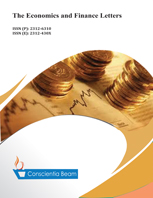Structural Breaks, Electricity Generation and Economic Growth in Nigeria
DOI:
https://doi.org/10.18488/journal.29.2019.62.170.177Abstract
Instability and low electricity generation in Nigeria has continued to raise concerns. The power sector reforms aimed at enhancing increased and stable electricity generation over the decades have not been economic growth oriented. Among other factors, obsolete and poor infrastructural equipment as well as inadequate investment has continued to impede the optimal impact of the power sector. This paper used full sample VAR and structural breaks approach-rolling impulse response(RIR) model-to obtain evidence for changes in the impact of electricity generation on Nigerian economic growth based on quarterly data from 1970 to 2016. Findings revealed that electricity generation does not Granger-cause real GDP growth rate and gross fixed capital formation, while a short-run relationship exist for labour force. No strong dynamic relationship exists between electricity generation and real GDP growth over the lag period. Lastly, result from RIR technique also showed that real GDP growth rate does not respond to impulses from electricity generation over the years, but for weak impact in the early 1980s.

